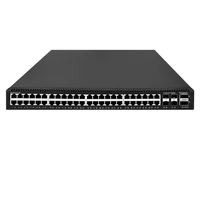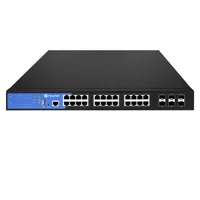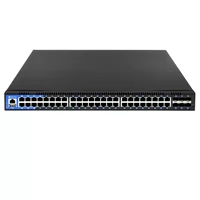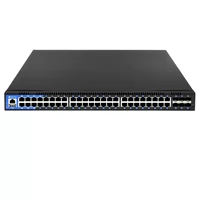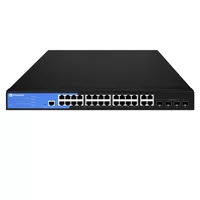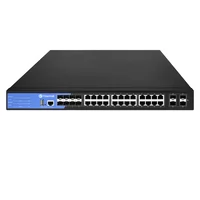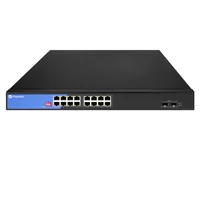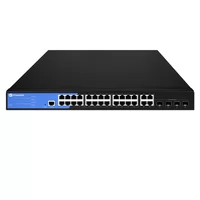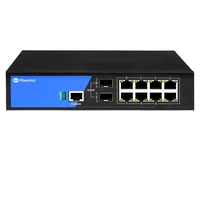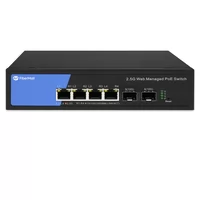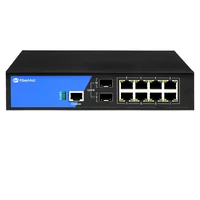Traditional gigabit Ethernet is being replaced with multi-gigabit networking because modern computing and connectivity demands have outgrown it. This shift is driven by the need to lower cost and improve access to fast network performance—what is popularly termed as the 2.5 GB switch. You may be a tech aficionado looking to optimize your home network, a small business owner updating your network, or an IT expert managing bandwidth-intensive tasks. You will find this guide helpful regarding the adoption of 2.5 GB switches. With the help of this technology, you can increase your network’s performance and capacity, enabling it to handle today’s high-speed and high-capacity requirements for data.
Table of Contents
ToggleWhat is a 2.5 GB Switch, and Why Do You Need It?

A 2.5 GB Switch or 2.5G switch enables data transfer at a speed of up to 2.5 Gigabits per second (Gbps) on the connected devices. There is a distinct advantage over older 1 Gbps switches, making this switch a good option for peripheral devices like homes with many smart devices, small businesses, and setups using Wi-Fi 6 technology. This type of switch solves the issues of data delay where data transmission is bottlenecked and improves the performance for streaming, transferring large files, and online gaming. 2.5 GB switches efficiently use resources and infrastructure as they do not require costly advanced technologies like 10 switches while modernizing the network capacity, surpassing the traditional 1 Gbps switches.
Understanding 2.5 Gigabit Ethernet
Compared with the traditional 1 Gbps Ethernet, 2.5 Gigabit Ethernet offers up to 2.5 times the bandwidth, providing a considerable jump in network speed. It is optimized to operate over existing Cat5e or Cat6 cabling, which avoids the expensive need for rewiring, especially in a 10g network upgrade scenario. This is particularly helpful in the increasing bandwidth requirement regions like offices, small businesses, or homes that have modern devices and Wi-Fi 6 Routers. 2.5 Gigabit Ethernet positioned itself as a cost-effective Ethernet solution with increased speed, improving network efficiency, and altering network performance, sitting between regular Ethernet options and more expensive high-speed choices.
Benefits of Using a 2.5 GB Switch
- Enhanced Network Speeds: A 2.5 GB switch enables higher data transfer rates than conventional Gigabit Ethernet has, surpassing the bandwidth requirements of modern devices and applications.
- Cost-Effective Upgrade: It uses existing Cat5e or Cat6 cabling, drastically increasing performance with no costly infrastructure changes.
- Improved Performance for High-Demand Applications: This is perfect for video streaming, gaming, or any large file transfer where connected devices need to deliver smooth, lag-free experiences.
- Scalability: Supports device and network expansion without seamless integration challenges to existing networks.
- Compatibility with Wi-Fi 6: It synergizes with Wi-Fi 6 routers and endpoints to enhance the wireless network’s efficiency and speed.
Comparing 2.5 GB Switch to Traditional Gigabit Switches
Compared to traditional gigabit switches, a 2.5 GB switch offers significantly higher bandwidth, allowing data transfer speeds up to 2.5 times faster. This is advantageous for demanding applications such as 4K video streaming, online gaming, and modern heavy networking workplace environments. Furthermore, 2.5 GB switches can function over existing Cat5e or Cat6 cabling, saving expensive infrastructure upgrade costs. Gigabit switches are satisfactory for the average home or small office setup, but 2.5 GB switches are necessary to address the scalability and performance requirements of advanced devices and applications.
How to Choose the Best Fanless Design for Your Needs?

Advantages of a Fanless Switch
A fanless switch has some essential benefits, especially regarding reliability, efficiency, and noise level. The device operates without noise because it employs no mechanical fans, which is ideal for sensitive environments such as offices or homes. Silence is not the only benefit; moving parts can also fail mechanically. The lack of these extra parts improves durability and maintenance and is cost-effective. In addition, fanless designs require less energy to function. These traits mark them as dependable and maintenance-free, thus practical for quiet network operations.
Factors to Consider for Power Consumption and Noise
While measuring power consumption and noise levels on a Poe switch setup, it is essential to assess the following:
- Device Efficiency: Choose to work with devices that have energy-efficient endorsements like Energy Star, as they will optimize power savings without affecting performance.
- Operating Environment: Consider what range of noise is acceptable. Offset or silenced devices are best suited for tranquil regions such as offices and homes.
- Thermal Management: Although some devices utilize fans, many can be quieter, less power-intensive, and employ passive cooling devices.
- Load Capacity: Balance the device rating against the expected workload. A mismatch could result in unwarranted energy consumption and overheating, drawing excessive power to cool the system, thus increasing noise levels.
Considering all these factors will provide a solution that creates harmony between power usage and noise for your networking setup.
Does a 2.5g Unmanaged Switch Fit Your Networking Requirements?

When to Opt for an Unmanaged Switch
An unmanaged switch is best suited for users requiring an out-of-the-box solution without advanced configuration options. It works well in small networks, home setups, or any scenario where the user needs minimal maintenance and simple connectivity. Furthermore, unmanaged switches are beneficial from a financial standpoint as they are less expensive than managed switches, particularly in smaller networks that require multiple ports. Select this option if your networking requirements are essential, mainly when dealing with a power switch.
Exploring the Capabilities of an Unmanaged Ethernet Switch
Unmanaged Ethernet switches have basic networking features, such as allowing communication between devices in a local area network (LAN) through automatic data routing to pre-set destinations. They are plug-and-play devices that do not require configuration, making them useful in simple network setups. These switches only work with the MAC addresses of the attached devices, enabling data forwarding, which guarantees communication with almost no user action. Due to their uncomplicated and dependable nature, Unmanaged Ethernet switches help accomplish basic networking tasks in small-scale environments.
How Can PoE Enhance the Capabilities of Your 2.5 GB Network Switch?

Understanding Power Over Ethernet
Power over Ethernet (PoE) is a technology that allows for power and data to be sent to a device through a single network cable, simplifying installation requirements and minimizing extra electrical cabling. PoE is critical in contemporary networking because of its effectiveness and adaptability in providing power to devices like wireless access points, IP cameras, VoIP phones, and IoT devices.
IEEE 802.3af (PoE), IEEE 802.3at (PoE+), and IEEE 802.3bt (PoE++) are examples of PoE standards and their corresponding frameworks that provide progressively increasing power outputs. For example, PoE provides 15.4 W, PoE + provides up to 30 W, while PoE++ can be either 60W or 90W, depending on its implementation. These different power levels can accommodate sensors with low power requirements and demanding industrial displays and equipment.
The ability to position devices in locations without electric outlets demonstrates the installation flexibility provided by PoE. This capability lowers the installation cost typically incurred for basic power requirements. Moreover, PoE solutions enable easier upkeep and problem resolution as power and data are integrated, making such networks ideal for environments with many required ports.
Incorporating Power over Ethernet (PoE) with a 2.5 GB network switch elevates the network’s performance by increasing data throughput and accommodating more advanced power and bandwidth-demanding devices. This combination guarantees that the network systems are enduring, particularly for areas that need flexible and effective solutions like smart buildings, surveillance equipment, and enterprise IT systems. The effortless integration of PoE with high-speed networking dramatically improves efficiency in connectivity and operations.
Benefits of Integrating PoE with Multi-Gig Switches
- Simplified Installation: Power over Ethernet (PoE) Technology eliminates separate power cables, thus reducing installation complexity and costs while enabling easier deployment of access points, cameras, and VoIP phones.
- Scalability: Support from Multi-Gig switches is offered at higher data rates, which helps alleviate growing network demand and aging devices that require more bandwidth.
- Reliability: Centralized power management improves system reliability by providing consistent power delivery and outage protection, making PoE more reliable.
- Operational Efficiency: Combining Multi-Gig technology with PoE guarantees maximum infrastructure utilization, reduction in energy consumption, and enhanced overall network performance.
- Future Readiness: Its integration of modern technologies and support for high-bandwidth applications make it most suitable for emerging smart office environments and IoT ecosystems.
What are the Upgrade Options Available for 2.5 GB Switches?

Assessing Bandwidth Requirements for Scalability
When analyzing the bandwidth requirements for a 2.5g switch – one that is scalable – it is imperative to consider both the current and future requirements of the network. Commence with an audit estimating data consumption per device and the total number of connected devices. Consider the types of applications in use, especially high bandwidth ones such as video conferencing, cloud-based services, or any other relevant applications. Make sure that the switch can handle peak traffic volumes while maintaining performance at the same time. From an emerging technology perspective, add ten GB or multi-gig switches with higher port speeds to increase bandwidth capacity for long-term scalability. Also, modular upgrade paths should be considered to ensure an adaptable switch that can cater to mounting demand.
Exploring Advanced Features and Compatibility with Other Devices
While looking into switches with more advanced functionalities, pay special attention to those supporting automated network management features like MPLS (Multiprotocol Label Switching) or SDN (Software-Defined Networking), as these will enhance performance and optimize configurations. Ensure that the switch is compatible with other devices by ensuring it meets the industry’s requirements, such as supporting the PoE (Power over Ethernet) for Ethernet ports and the IEEE 802.3 Ethernet standard. Ensure that the other network devices, such as routers, access points, and security appliances, will work with the new system to avoid integration problems. Prefer switches that operate on a single management system for easy supervision and control, facilitating uncomplicated deployment and maintenance activities after implementation.
Frequently Asked Questions (FAQs)
Q: What is a 2.5GB switch?
A: A 2.5GB switch, commonly known as a 2.5 GBE switch, improves the network’s efficiency by enabling data exchange rates of 2.5 Gbps for every port. This change from standard 1 GB switches promotes smoother file transfers while also allowing the use of higher-bandwidth applications.
Q: Which devices stand to gain the most from using a 2.5 GB network switch?
A: Enhanced data transfer speeds coupled with latency reduction make devices such as NAS (Network Attached Storage), smart-managed routers, gaming consoles, and computers stand to gain significantly from using a 2.5 GB network switch.
Q: How can I switch to 2.5 Gbps without replacing all my hardware?
A: By adding a 2.5 GbE adapter and cat6 cables, there is no need to replace any existing infrastructure to switch to 2.5 Gbps. This means that compatible devices will instantly convert to the 2.5 Gbps speed when plugged into a 2.5 GB switch.
Q: What are the factors to consider when selecting a multi-gigabit 2.5gbe switch?
A: For network administration purposes, the number of ethernet ports, such as five and 8-port PoE switches, PoE features, and managed or innovative managed capabilities, must be considered when selecting a multi 2.5 GBE switch.
Q: Is it possible to connect a 2.5gbe switch to existing cat6 cabling?
A: Absolutely. A 2.5gbe switch can utilize existing Cat6 cabling to provide 2.5gbps speeds, making it a cost-efficient enhancement for the system.
Q: What should be done to ensure a home router is compatible with a 2.5 GB switch?
A: To guarantee a 2.5 GB switch compatibility with routers and other devices, it must possess a minimum of one port rated 2.5 GB or above. Alternatively, using an sfp adapter provides direct connectivity with the 2.5 GB switch, guaranteeing seamless integration with the network.
Q: What are the benefits provided by a Netgear 2.5gb switch?
A: The benefits of using a Netgear 2.5 GB switch are numerous, including excellent device build quality and performance. Additionally, it is furnished with VLAN, which aids in traffic management in both enterprise and home networks, creating stronger reliability.
Q: Are 2.5gbe switches compatible with WiFi 6 networks?
A: With optimal speed connections, 2.5gbe switches can indeed support WiFi 6 networks, ensuring they take full advantage of the capabilities provided by WiFi 6 routers.
Q: Is a fanless 2.5gbe switch recommended for home use?
A: The ultimate cheap fanless 2.5gbe switch and other fanless 2.5gbe switches are advised for home use due to their low noise levels and good heat management.
Reference Sources
1. A Crosspoint Switch With Fast Programming: 2.5 Gb/s 16×16 Bit Crosspoint Switch
- Authors: R. Savarã, A. Turudic
- Date of Publication: 1995-10-29
- Summary: This paper presents a new 2.5 Gb/s crosspoint switch designed using source-coupled logic GaAs MESFET logic cells. The switch is also capable of fast programming, which allows for a data path rate of 2.5 Gb/s, which equates to an aggregate bandwidth of 40 Gb/s. The programming techniques and architecture designed to enhance the switch’s performance are the main considerations.
- Citation: (Savarã & Turudic, 1995, pp. 47–48)
2. A Prototype Growable 2.5 Gb/s ATM Switch for Broadband Applications
- Authors: K. Eng et al.
- Publication Date: 1992-07-01
- Summary: This work describes a prototype 2.5 Gb/s ATM switch fabric we built for flexible broadband applications. The switch supports many standard line card peripherals and has a broad range of interfaces. With hierarchical multiplexing, it achieves optimal delay-throughput performance. Its configuration is scalable from 8×8 to larger configurations, overcoming many operational issues.
- Citation: (Eng et al., 1992, pp. 237–253)
3. A 2.5 Gb/s ATM switch chipset
- Authors: P. Plaza et al.
- Publication Date: 1996-09-01
- Summary: In this paper, the authors present the design and construction of two application-specific integrated circuits (ASICs) for an ATM switch. The chipset contains an input/output processor and a cell-switching IC with 2.5 Gb/s switching per input/output. The research highlights the switch’s effectiveness concerning burst traffic.
- Citation: (Plaza et al., 1996, pp. 405–416)
Related Products:
-
 S3100-48T2Q4X, 48-Port Ethernet Switch, 48x 10/100/1000/2500/10G BASE-T RJ45, with 2x 40G SFP+ and 4x 1G/10G SFP+ Uplinks
$1095.00
S3100-48T2Q4X, 48-Port Ethernet Switch, 48x 10/100/1000/2500/10G BASE-T RJ45, with 2x 40G SFP+ and 4x 1G/10G SFP+ Uplinks
$1095.00
-
 S3100-24T6X-P, 24-Port Ethernet Switch L3, PoE+ Switch, 24x 10/100/1000/2500 BASE-T RJ45, with 6x 1G/10G SFP+ Uplinks
$746.00
S3100-24T6X-P, 24-Port Ethernet Switch L3, PoE+ Switch, 24x 10/100/1000/2500 BASE-T RJ45, with 6x 1G/10G SFP+ Uplinks
$746.00
-
 S3100-48T6X-P, 48-Port Ethernet Switch L3, PoE+ Switch, 48x 10/100/1000BASE-T RJ45, with 6x 1G/10G SFP+ Uplinks
$734.00
S3100-48T6X-P, 48-Port Ethernet Switch L3, PoE+ Switch, 48x 10/100/1000BASE-T RJ45, with 6x 1G/10G SFP+ Uplinks
$734.00
-
 S3100-8T4X, 8-Port Ethernet Switch L3, 8x 10/100/1000/2500/10G BASE-T RJ45 Ports, with 4x 1G/10G SFP+ Uplinks
$398.00
S3100-8T4X, 8-Port Ethernet Switch L3, 8x 10/100/1000/2500/10G BASE-T RJ45 Ports, with 4x 1G/10G SFP+ Uplinks
$398.00
-
 S3100-48T6X, 48-Port Ethernet Switch L3, 48x 10/100/1000BASE-T RJ45, with 6x 1G/10G SFP+ Uplinks
$365.00
S3100-48T6X, 48-Port Ethernet Switch L3, 48x 10/100/1000BASE-T RJ45, with 6x 1G/10G SFP+ Uplinks
$365.00
-
 S2100-24T4TS-P, 24-Port Ethernet Switch L2+, PoE+ Switch, 24x 10/100/1000BASE-T RJ45, with 4x 1G RJ45/SFP Combo Uplinks
$360.00
S2100-24T4TS-P, 24-Port Ethernet Switch L2+, PoE+ Switch, 24x 10/100/1000BASE-T RJ45, with 4x 1G RJ45/SFP Combo Uplinks
$360.00
-
 S3100-16T8TS4X, 16-Port Ethernet Switch L3, 16x 10/100/1000BASE-T RJ45, with 8 x 1Gb RJ45/SFP Combo and 4 x 1Gb SFP Uplinks
$340.00
S3100-16T8TS4X, 16-Port Ethernet Switch L3, 16x 10/100/1000BASE-T RJ45, with 8 x 1Gb RJ45/SFP Combo and 4 x 1Gb SFP Uplinks
$340.00
-
 S2100-16T2S-P, 16-Port Ethernet Switch L2+, PoE+ Switch, 16x 10/100/1000BASE-T RJ45, with 2x 1G SFP Uplinks
$230.00
S2100-16T2S-P, 16-Port Ethernet Switch L2+, PoE+ Switch, 16x 10/100/1000BASE-T RJ45, with 2x 1G SFP Uplinks
$230.00
-
 S2100-24T4TS, 24-Port Ethernet Switch L2+, 24x 10/100/1000BASE-T RJ45, with 4x 1G RJ45/SFP Combo Uplinks
$148.00
S2100-24T4TS, 24-Port Ethernet Switch L2+, 24x 10/100/1000BASE-T RJ45, with 4x 1G RJ45/SFP Combo Uplinks
$148.00
-
 S2100-8T2S-P, 8-Port Ethernet Switch L2+, PoE+ Switch, 8x 10/100/1000BASE-T RJ45, with 2x 1G SFP Uplinks
$139.00
S2100-8T2S-P, 8-Port Ethernet Switch L2+, PoE+ Switch, 8x 10/100/1000BASE-T RJ45, with 2x 1G SFP Uplinks
$139.00
-
 S3100-4T2X-P, 4-Port Gigabit Ethernet Managed Switch, PoE+ Switch, 4x 10/100/1000/2500 BASE-T RJ45, with 2x 1G/10G SFP+ Uplinks
$90.00
S3100-4T2X-P, 4-Port Gigabit Ethernet Managed Switch, PoE+ Switch, 4x 10/100/1000/2500 BASE-T RJ45, with 2x 1G/10G SFP+ Uplinks
$90.00
-
 S2100-8T2S, 8-Port Ethernet Switch L2+, 8x 10/100/1000BASE-T RJ45, with 2x 1G SFP Uplinks
$71.00
S2100-8T2S, 8-Port Ethernet Switch L2+, 8x 10/100/1000BASE-T RJ45, with 2x 1G SFP Uplinks
$71.00

